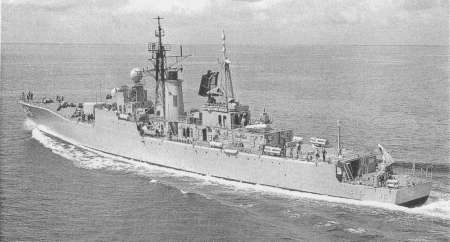- Author
- Gillett, Ross
- Subjects
- Ship design and development, Ship histories and stories
- Tags
-
- RAN Ships
- HMAS Derwent, HMAS Stuart II, HMAS Parramatta III, HMAS Swan III, HMAS Torrens II, HMAS Yarra III
- Publication
- December 2007 edition of the Naval Historical Review (all rights reserved)
This article first appeared in The Australian Warship Review, Vol. 4/1999.
From 1961 to 1998, varying numbers of the long-serving Type 12 (or River class) antisubmarine frigates served in the Royal Australian Navy. The first pair, HMA Ships Parramatta and Yarra were commissioned on 14 July 1961 and 27 July 1961 respectively. The second group, comprising HMA Ships Derwent and Stuart were commissioned on 30 April 1963 and 28 June 1963. The final pair, HMA Ships Swan and Torrens, were commissioned on 20 January 1970 and 19 January 1971.
The ten year gap between the delivery of the first frigate, Parramatta, and the last, Torrens, witnessed a gradual improvement in the capabilities of the ships as well as changes to their external appearances. The departure from service of Yarra in November 1985, and Torrens in 1998 was also marked by a thirteen year gap. Over the thirty seven years that the class was in service, a good proportion of the Navy’s officers and sailors of all ranks and seniorities served in them. They represented the backbone of the Fleet.
The River class was conceived as replacements for the Second World War vintage Q class destroyers, which were converted to fast anti-submarine frigates. When first proposed, the new ASW frigates were estimated to cost approximately $4 million per ship, with building scheduled to begin in 1954. Based on the British Whitby and Rothesay classes, four Australian variants were initially constructed at the Cockatoo Island and Williamstown Naval Dockyards, with each site delivering one frigate from each of the two early sub-groups. Both dockyards again shared the construction of the fifth and sixth ships in the late 1960s and early 1970s.

The ship was modernised as part of a half life refit. Note the Ikara and Seacat missile launchers.
(Image:RAN)
Parramatta and Yarra, the first frigates delivered, were completed with a twin 40mm Bofors mounting and two triple barreled Limbo anti-submarine mortars mounted aft. Guided missile systems to counter aircraft and submarine threats were added from 1963 to 1967, including the quadruple Seacat launcher in place of the Bofors and the Australian designed Ikara launcher for the after Limbo.
Stuart and Derwent, the second pair to commission, gained distinction as the first ships to enter service with Ikara and Seacat respectively, both fitted during building. Another feature of the design of the second pair, was the flushed hull on the port side aft, so designed to accommodate a control cabin and deck space for the contemporary variable depth sonar.
A change from the traditional Type 12 hull was incorporated into Swan and Torrens, whose design resembled the Leander general purpose frigate in service with the Royal Navy and Royal New Zealand Navy. These ships also featured a special Ikara aperture on the starboard side aft, (from where the missile was launched), the radar re-sited further aft and lower on the superstructure, a more squat funnel and a redesigned bipod mast. The River class frigates were by this stage re-categorised as destroyer escorts.
As well as serving in the warship role, the River class destroyer escorts have served as diplomats. Derwent, in company with HMAS Brisbane, took part in the first bilateral naval exercises with Indonesia, whilst some of her sister ships visited China as well as the regular South East Asian and Pacific ports.
In 1967, Derwent’s ship’s company assisted in fighting bushfires in Tasmania, whilst Stuart was one of the first naval vessels to arrive in Darwin after the devastation of Cyclone Tracy. Then, following a devastating earthquake in Bali in 1976, Parramatta was diverted to render assistance to the local community. From 17 July to 21 July officers and sailors from Parramatta worked alongside locals in helping to clean up and rebuild around the town of Seririt.
Modernisation
In an effort to maintain the capabilities of five of the vessels, a modernisation program was instituted, including the replacement of the original steam generator, an upgrade of the electrical system, a redesigned mast and funnel and a golfball radar dome. As the modernisations progressed, the number of ships to be modified was reduced from five to three units, Parramatta completing in late 1981, Stuart in late 1983 and Derwent in May, 1985. Yarra, meanwhile had undergone a limited half-life refit from October, 1976 to December, 1977, which included the fitting of the Australian designed Mullolca sonar.
Operational Service
All of the frigates experienced operational service in south-east Asia and represented the Navy in many international exercises including RIMPAC in the Hawaiian Islands. In September 1981, Swan gained the distinction of being the first RAN warship to visit China in 32 years, when she called into Shanghai. Then in 1983, Stuart and Yarra visited Shanghai with the destroyer tender HMAS Stalwart. In 1986 during the RAN’s 75th Anniversary year, the 1961 veteran Parramatta also visited mainland China, while Swan was appointed the official guard ship for the defence of the America’s Cup in 1987.




